
Sexual Exploits and Exploitation along the Silk Road
The Silk Road created a convergence of cultures like no other. The route is deemed influential by historians because of the contributions it made to trade and the economy, as well as society in general. One aspect of the Silk Road that is less talked about is its relationship with sex and intimacy.
Along the Silk Road, people from all over the world mingled. This encouraged a medley of social traditions and norms. The resulting cocktail of differing religious and social ideologies meant the norms of one's hometown could be easily ignored. This fostered a sense of freedom, with both positive and negative consequences.
There was no shortage of sex along the Silk Road, taking many forms, from sex slaves and prostitutes, to how-to manuals and medicine. This article will explore all of these and more, in an attempt to understand the nature of sex and love on the Silk Road.
- A Guide to Exploring Love, Sex, and Homosexuality in Ancient Rome
- Bronze Age Settlement Uncovered in China Reveals Silk Road Origins

Caravan on the Silk Road, circa 1375 (Public Domain)
Marco Polo on Love and Sex on the Silk Road
Marco Polo was a Venetian merchant who lived between 1254 and 1324. He was famous for his travels across Asia during the height of the Mongol Empire. His travelogue remains one of the best sources on travel and trade during this period because he recorded so many of his experiences.
Marco Polo’s writings have revealed much to historians about life on the Silk Road, and he even mentioned some aspects of love and sex. Polo mentioned sexual relations most explicitly when he talked about how homeowners along the Silk Road offered up their home to travelers in need of rest.
Polo stated that not only did these men offer up their homes, but they also often offered up their wives as well! He wrote:
“the host is delighted, and desires his wife to put herself entirely at the guest's disposal, whilst he himself gets out of the way, and comes back no more until the stranger shall have taken his departure. The guest may stay and enjoy the wife's society as long as he likes, whilst the husband has no shame in the matter, but indeed considers it an honor. And all the men of this province are made wittols of by their wives in this way. The women themselves are fair and wanton.” (Marco Polo, cited Ranker)
Polo proceeded to confess that the Mongols were not really happy about this convention, but they still let the men continue with it. The motivations for such actions seem somewhat hazy. It may have been that the travelers threatened these men into offering up their wives, or that the husbands received payments for the offer. What we can assume with near certainty is that the women had little say in the matter.

Many women living along the Silk Road ended up involved in a sex trade. Oil painting ‘Choosing the Favorite’ by Giulio Rosati (Public Domain)
It was not only simple merchant travelers who used the Silk Road to their sexual advantage, according to Polo. Wealthier journeyers used the route to facilitate their sexual exploitation of women on an even larger scale.
For example, Polo recorded how every year one hundred women were sent to the “Great Khan” who would then:
“commit them to the charge of certain elderly ladies dwelling in his palace... then such of them as are of approved beauty, and are good and sound in all respects, are appointed to attend on the Emperor by turns. Thus six of these damsels take their turn for three days and nights, and wait on him when he is in his chamber and when he is in his bed, to serve him in any way, and to be entirely at his orders. At the end of the three days and nights they are relieved by other six. And so throughout the year, there are reliefs of maidens by six and six, changing every three days and nights.”
So not only did sex and intimacy exist in their physical forms along the Silk Road, but the route also acted as a facilitating vector for later, more large-scale sexual trafficking.
- Poet Sappho, the Isle of Lesbos, and Sex Tourism in the Ancient World
- Treacherous Trading: Dangers of the Silk Road
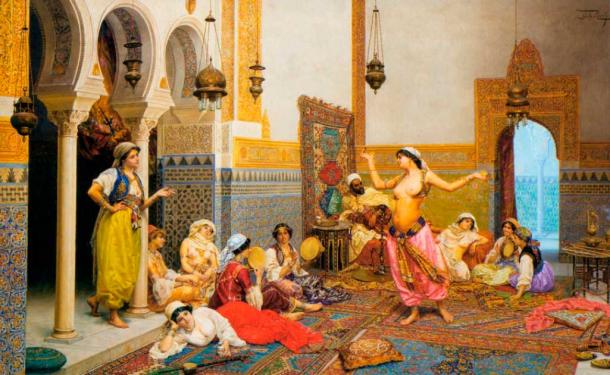
Oil painting of The Harem Dance by Giulio Rosati. Along the Silk Road, women were sexually exploited on the streets, as well as by elite rulers like Genghis Khan. (Public Domain)
Sexual Exchanges on the Silk Road
There were a large number of ways in which people participated in sexual activities on the Silk Road, both consensual and non-consensual.
The Silk Road was used to transport all kinds of slaves from place to place, and sex slaves were no exception. Although the attitudes of the Romans to sex slaves and concubines are not always clear, there is substantial evidence to suggest that there were often intimate relationships between powerful male owners and their female slaves.
While many women began their journey on the Silk Road as sex slaves, some did not. Many began their journey free and were then kidnapped and sold. Specific stories from history illustrate this well.
A woman by the name of Wenji, who lived in the 2nd century AD, was captured, taken away, and forced to marry a nomad warlord. Fortunately, she was eventually rescued from this unhappy marriage; however, she had produced two children from the union. Although she had fled the forced marriage, she mourned the loss of her children and her nomad family.

Portrait of Lady Wenji, ink and colors on silk, from a Qing dynasty collection titled Gathering Gems of Beauty (Public Domain)
Later, in the 7th century, a woman named Wencheng was kidnapped and transported to China, where she became the bride of a Tibetan ruler. The union was celebrated in both countries. It is important to acknowledge that this likely happened to many women, and men, when traveling the Silk Road, but we are limited to the stories that survive.
There were also sexual exchanges that blurred the line between consensual and non-consensual. In the Byzantine Empire, for example, it was common for women to sell themselves into sex work to survive.
At first, prostitution probably seemed like a lucrative trade. Lots of travelers, possibly with money to spare, who had spent months or years away from their wives, would have made decent customers. However, sex work came with its risks, and these women without a doubt faced violence. It is also likely that they did not have full entitlement to their money if they were working under a wealthy (most likely male) owner.
Silk was highly important in the Byzantine Empire, and therefore, many Byzantine traders traveled the Silk Road. With them, they brought their sexual appetites, as well as demand for ways to satiate themselves. So, cathouses sprang up along the part of the Silk Road which ran through the Byzantine Empire.
Aside from the more sinister sexual exchanges that took place on the Silk Road, it seems that people also had slightly more freedom to explore their sexuality there. In the early years of the Silk Road, Roman influences were strong. Because of this dominance, Roman ideas about same-sex relationships traversed the length of the Silk Road.
Of course, all the different cultures that converged on the Silk Road had differing opinions on such matters. Historians have uncovered that the Mongols probably engaged in homosexual activity in China as well as in the Russian khanates.
However, it is important to remember that many of these cultures were influenced by religion, which often looked down on such activity. In the Mongol case, for example, Islam had a tendency to view homosexual relations as improper, especially in polite society. Despite this, it often accepted such relations if they were conducted in private.
The Silk Road would have offered a great place, therefore, to carry out such activities. Far removed from one’s normal life, travelers were able to explore aspects of their identity that they otherwise may have been forced to hide.
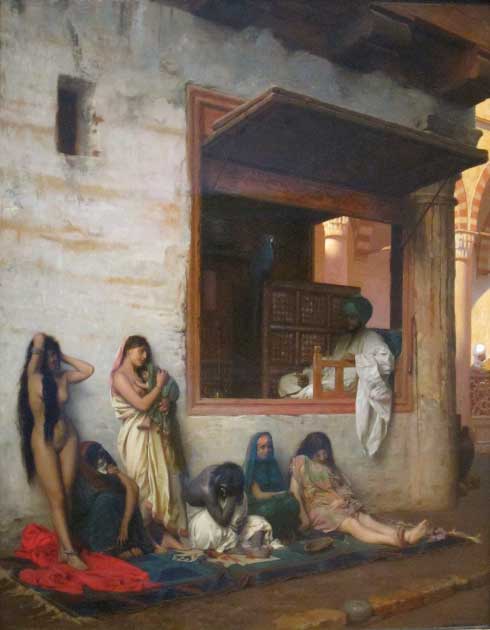
Women were frequently kidnapped and sold into slavery, or forced into sex work along the Silk Road. Oil painting of The Slave Market, by Jean-Léon Gérôme of Ottoman empire markets, 1871 (Public Domain)
The Spread of How-To Manuals and Sexual Guides on the Silk Road
Many ideas about sex and intimacy proliferated through society by way of the Silk Road. For example, according to a variation of Buddhism called Tantric Buddhism, the path to enlightenment was achieved through ecstasy. The teachings of this branch of Buddhism spread along the Silk Road, including the idea that sexual activities and practices could achieve this ecstasy.
Furthermore, the famous Kama Sutra, compiled in the 3rd or 4th century AD, spread along the Silk Road. This was a manual which contained instructions on intimate relations. It presented these relations as social and economic duties. However, the word ‘ kama’ translates to pleasure, implying that pleasure was also somewhat the goal as well.
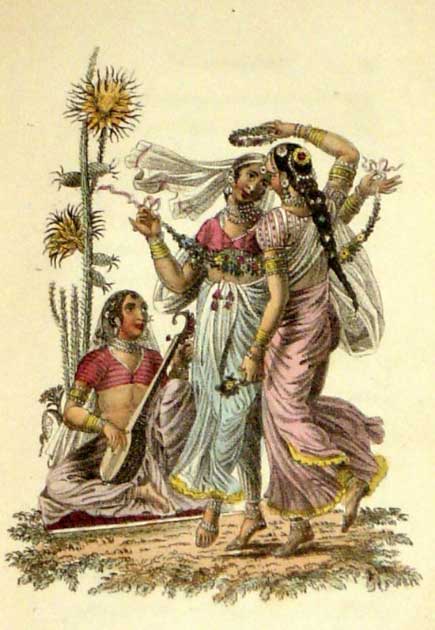
Young girls were frequently sold by their parents as devadasis, dedicated to Tantric Buddhism (Public Domain)
Sex and Political Power
Eunuchs commonly traveled the Silk Road and were used as diplomats and court officials in the late Roman and Byzantine Empires, as well as by dynastic leaders in China. Eunuchs were castrated men who were entrusted with services close to those in power.
Their existence on the Silk Road presents an interesting example of how sexuality and sexual identity, both physical and mental, played an important role in social status and social perception.
Through the act of castration, these men were seem as more trustworthy and less likely to give in to temptations. Because of this perceived neutrality, eunuchs were often respected in political as well as social spaces.
Zheng He was a Chinese explorer and eunuch who used the Silk Road to spread Chinese dynastic influence. Because of the perception of eunuchs as harmless and neutral, they were more approachable and therefore able to spread their message effectively.
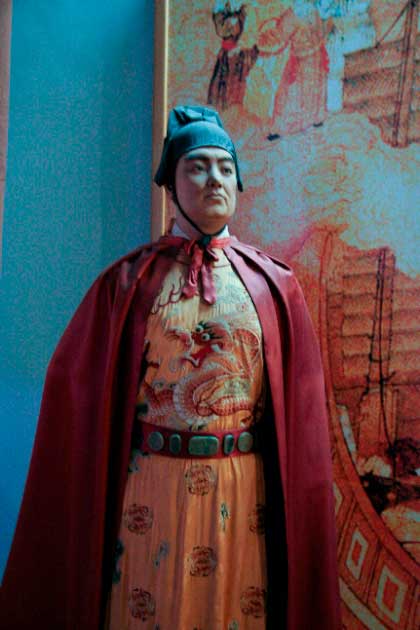
Wax figure of the fascinating Admiral Zheng He, a seven foot tall Chinese eunuch who commanded a fleet of 300 ships and an army of more than 30,000 men (jonjanengo / CC BY 2.0)
Sex and Medicine
Sexuality and sexual activity were also linked to medicinal practices. In ancient China, for example, it was generally believed that sex and intimacy could have therapeutic value. Many medical texts contained instructions on how to have proper intercourse, as well as what not to do. Like the Kama Sutra, these texts spread via the Silk Road, as did many other works which were not sexual in nature.
In the Tang Dynasty, another how-to sex manual was produced, called The Classic of the White Girl. It provided advice to men about how to have sex. While providing such instructions, it also emphasized the importance of sex for health and nature. In the book, one of the characters named Huangdi asked another character named Sunu what would happen if he abstained from sex. Sanu replies that:
“[it] is absolutely out of the question. Yin and yang have their alternations as does everything in nature. Human beings should follow the rhythms of yin and yang just as they follow the rhythms of the seasons…”
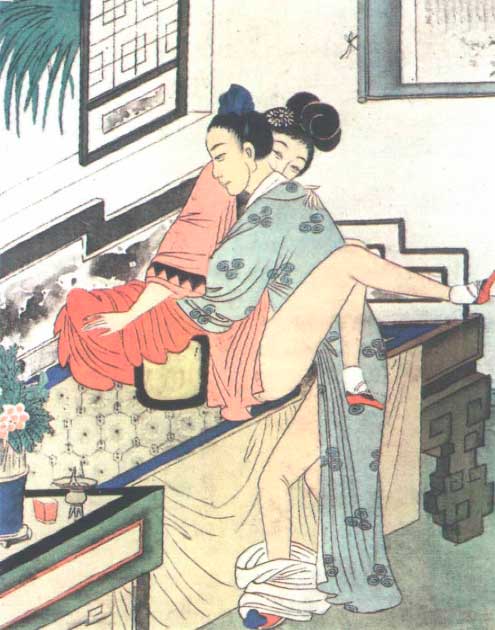
The Silk Road offered many opportunities for sexual adventure, including explorations of Tantric sex. A Chinese print depicting "The Joining of the Essences", based on Tang Dynasty art (Public Domain)
Conclusion
To conclude, the Silk Road facilitated many sexual activities and encounters, both immediate and removed. Not only did people take part in sexual activities while on the Silk Road, it also spread ideas about sex from one culture to the next, either through conversation, sharing of traditions or through the written word in how-to manuals.
Furthermore, the Silk Road enabled people to embrace their sexual identity. Eunuchs were protected by assumptions of neutrality, because of their perceived lack of manliness due to their castration. Many people were free to explore and express their sexual identities, removed from normal polite society and their families.
There is no doubt that the Silk Road also facilitated an unfathomable amount of sexual violence, surely towards all, but particularly towards women. Women were at risk of being kidnapped and forced into marriage in a distant, far-off land and at risk of being forced into sex work, either as a slave or by poverty.
Top Image: The Silk Road offered opportunities to explore, not only new lands, but new sexual adventures. Source: Demian / Adobe Stock
By Molly Dowdeswell
References
Chaudhary, K. September 14, 2021. Sex Adventures of the Silk Road. Lessons from History. Available at: https://medium.com/lessons-from-history/sex-adventures-of-the-silk-road-c68fba0e312e
Eunuch. New World Encyclopedia. Available at: https://www.newworldencyclopedia.org/entry/Eunuch#Greco-Roman_practice
Marco Polo. March 6, 2019. History.com. Available at: https://www.history.com/topics/exploration/marco-polo
Sartore, M. September 23, 2021. What Intimacy Was Like for Nomads Traveling The Silk Road. Weird History. Available at: https://www.ranker.com/list/intimacy-silk-road/melissa-sartore















Comments
While I agree with most of the article, I disagree with one part. The author says about guests sleeping with the wife of the hosts: "What we can assume with near certainty is that the women had little say in the matter."
Marco Polo's account described the women as being "wanton". This would surely not apply to women who were forced.
As for the rest, no doubt tens of thousands of women were kindnapped, rape and/or sold into slavery over a 15 to 1900 year period if not longer. It may still be happening today, in a less obvious way.
--
Robertus
Ukraine was the Silk Road of the early 21st century in some regards. There is copious evidence of human trafficking for sex from the nation of "stand by us". Journalists were aware of this a decade ago, but have since developed amnesia on the subject, for some reason. This is despite women being well-represented in the field of Western journalism.
On a separate note, I would also like to add my agreement with the first two comments, by Pete Wagner and Guillaume. Both are absolutely correct.
Nothng changes does it, all that went on then, goes on today.
"sexual violence, surely towards all, but particularly towards women."
Being castrated might compare, no?
Nobody gets paid to tell the truth.